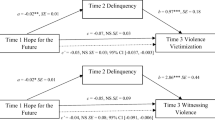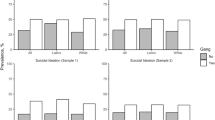Abstract
Prior research has identified a relationship between youth hopelessness and violence perpetration within specific groups of young people. The purpose of this study was to evaluate the relationship between youth hopelessness and violence perpetration in a population-based sample of adolescents. This study is a cross-sectional analysis of data from 136,549 students in the 6th, 9th, and 12th grades responding to the 2007 Minnesota Student Survey. Logistic regression models were used to evaluate the relationship between hopelessness and youth violence perpetration, including comparison analyses for gender and race/ethnic subgroups as well as adjustment for a measure of poor-low affect. One in four youth (25.1%) reported levels of hopelessness at least enough to bother them in the previous month. Moderate-high levels of hopelessness exhibited a statistically significant independent relationship with a range of violence-related outcomes for youth subgroups: delinquent behavior, weapon carrying on school property, and all forms of self-directed violence. Relationships between hopelessness and interpersonal and intimate partner violence suggest a greater contribution by poor affective functioning for some groups. Interventions designed to reduce youth violence perpetration may benefit from increased strategies to address youth hopelessness as well as youth mental health in general.
Similar content being viewed by others
References
Park, M. J., Brindis, C. D., Chang, F., & Irwin, C. E. (2008). A midcourse review of the Healthy People 2010: 21 critical health objectives for adolescents and young adults. Journal of Adolescent Health, 42(4), 329–334.
National Center for Chronic Disease Prevention & Health Promotion, Division of Adolescent & School Health. Youth Risk Behavior Surveillance System (YRBSS). 2007 YRBSS. http://www.cdc.gov/HealthyYouth/yrbs/indes.htm. Accessed on 10 Feb 2009.
National Center for Injury Prevention & Control. Web-based injury statistics query & reporting system (WISQARS). (2000–2007). http://www.cdc.gov/ncipc/wisqars/. Accessed on 10 Feb 2009.
Damon, W. (2008). The path to purpose, helping our children find their calling in life. New York: Free Press.
Gillham, J., & Reivich, K. (2004). Cultivating optimism in childhood and adolescence. The Annals of the American Academy of Political and Social Science, 591, 146–163.
Beck, A. T., Weissman, A., Lester, D., & Trexler, L. (1974). The measurement of pessimism: The hopelessness scale. Journal of Consulting and Clinical Psychology, 42(6), 861–865.
Ostrander, R., Nay, W. R., Anderson, D., & Jensen, J. (1995). Developmental and symptom specificity of hopelessness, cognitive errors, and attributional bias among clinic-referred youth. Child Psychiatry and Human Development, 26(2), 97–112.
Prociuk, T. J., Breen, L. J., & Lussier, R. J. (1976). Hopelessness, internal-external locus of control, and depression. Journal of Clinical Psychology, 32(2), 299–300.
Abramson, L. Y., Metalsky, G. I., & Alloy, L. B. (1989). Hopelessness depression: A theory-based subtype of depression. Psychological Review, 96(2), 358–372.
Nolen-Hoeksema, S., Girgus, J. S., & Seligman, M. E. P. (1986). Learned helplessness in children: A longitudinal study of depression, achievement, and explanatory style. Journal of Personality and Social Psychology, 51(2), 435–442.
Peterson, C. (1991). The meaning and measurement of explanatory style. Psychological Inquiry, 2(1), 1–10.
Peterson, C., & Seligman, M. E. P. (1984). Causal explanations as a risk factor for depression: Theory and evidence. Psychological Review, 91(3), 347–374.
Peterson, C., Seligman, M. E. P., & Vaillant, G. E. (1988). Pessimistic explanatory style is a risk factor for physical illness: A thirty-five year longitudinal study. Journal of Personality and Social Psychology, 55(1), 23–27.
Asarnow, J. R., Carlson, G. A., & Guthrie, D. (1987). Coping strategies, self-perceptions, hopelessness, and perceived family environments in depressed and suicidal children. Journal of Consulting and Clinical Psychology, 55(3), 361–366.
McLaughlin, J., Miller, P., & Warwick, H. (1996). Deliberate self-harm in adolescents: Hopelessness, depression, problems, and problem-solving. Journal of Adolescence, 19, 523–532.
Cole, D. A. (1989). Psychopathology of adolescent suicide: Hopelessness, coping beliefs, and depression. Journal of Abnormal Psychology, 98(3), 248–255.
Metha, A., Chen, E., Mulvenon, S., & Dode, I. (1998). A theoretical model of adolescent suicide risk. Archives of Suicide Research, 4, 115–133.
Thompson, E. A., Mazza, J. J., Herting, J. R., Randell, B. P., & Eggert, L. L. (2005). The mediating roles of anxiety, depression, and hopelessness on adolescent suicidal behaviors. Suicide and Life Threatening Behavior, 35(1), 14–34.
Bolland, J. M. (2003). Hopelessness and risk behavior among adolescents living in high-poverty inner-city neighborhoods. Journal of Adolescence, 26, 145–158.
Bolland, J. M., McCallum, D., Lian, B., Bailey, C. J., & Rowan, P. (2001). Hopelessness and violence among inner-city youths. Maternal and Child Health Journal, 5(4), 237–244.
DuRant, R. H., Cadenhead, C., Pendergrast, R. A., Slavens, G., & Linder, C. W. (1994). Factors associated with the use of violence among urban Black adolescents. American Journal of Public Health, 84(4), 612–617.
DuRant, R. H., Getts, A., Cadenhead, C., Emans, S. J., & Woods, E. R. (1995). Exposure to violence victimization and depression, hopelessness, and purpose in life among adolescents living in and around public housing. Developmental and Behavioral Pediatrics, 16(4), 233–237.
Minnesota Department of Education (MDE). (2007). Minnesota Student Survey. http://www.education.state.mn.us/mde/Learning_Support/Safe_and_Healthy_Learners/Minnesota_Student_Survey/index.html. Accessed on 1 Aug 2008.
Pharris, M. D., Resnick, M. D., & Blum, R. W. (1997). Protecting against hopelessness and suicidality in sexually abused American Indian adolescents. Journal of Adolescent Health, 21(6), 400–406.
Kazdin, A. E., Rodgers, A., & Colbus, D. (1986). The hopelessness scale for children: Psychometric characteristics and concurrent validity. Journal of Consulting and Clinical Psychology, 54(2), 241–245.
Data and Statistical Services (DSS). (2007). Multicollinearity and singularity. http://www.dss.wikidot.com/multicollinearity-and-singularity. Accessed on 15 Feb 2009.
Wulder, M. (2007). Multicollinearity and singularity. http://www.cfs.nrcan.gc.ca/subsite/wulder/multicol. Accessed on 31 Jan 2009.
Department of Health and Human Services (DHHS). (2001). Youth violence: A report of the surgeon general. Rockville, MD: US Department of Health and Human Services, Centers for Disease Control and Prevention, National Center for Injury Prevention and Control; Substance Abuse and Mental Health Services Administration, Center for Mental Health Services; and National Institutes of Health, National Institute of Mental Health. http://www.surgeongeneral.gov/library/youthviolence/youvioreport.html. Accessed on 31 Jan 2009.
Borowsky, I. W., & Ireland, M. (2004). Predictors of future fight-related injury among adolescents. Pediatrics, 113(3), 530–536.
Borowsky, I. W., Ireland, M., & Resnick, M. D. (2001). Adolescent suicide attempts: Risks and protectors. Pediatrics, 107(3), 485–493.
Resnick, M. D., Ireland, M., & Borowsky, I. W. (2004). Youth violence perpetration: What protects? What predicts? Findings from the National Longitudinal Study of Adolescent Health. Journal of Adolescent Health, 35, 424.e1–424.e10.
National Adolescent Health Information Center (NAHIC). (2006). Fact sheet on suicide: Adolescents & young adults. San Francisco, CA: Author, University of California, San Francisco.
National Adolescent Health Information Center (NAHIC). (2007). Fact sheet on violence: Adolescents & young adults. San Francisco, CA: Author, University of California, San Francisco.
Department of Health and Human Services (DHHS). (2007). Report to the President on Issues by the Virginia Tech Tragedy. Washington, DC: US Department of Health and Human Services. http://www.hhs.gov/vtreport.html. Accessed on 12 Feb 2009.
Vossekuil B, Fein R, Reddy M, Borum R, Modzeleski W. (2002). The final report and findings of the Safe School Initiative: Implications for the prevention of school attacks in the United States. Washington, D.C.: US Department of Education, Office of Elementary and Secondary Education, Safe and Drug-Free Schools Program and US Secret Service, National Threat Assessment Center. http:www.secretservice.gov/ntac/ssi_final_report.pdf. Accessed on 12 Feb 2009.
Holmbeck, G. N. (1997). Toward terminological, conceptual, and statistical clarity in the study of mediators and moderators: Examples from the child-clinical and pediatric psychology literatures. Journal of Consulting and Clinical Psychology, 65(4), 599–610.
Snyder, C. R. (2002). Hope theory: Rainbows in the mind. Psychological Inquiry, 13(4), 249–275.
Borowsky, I. W., Widome, R., & Resnick, M. D. (2008). Young people and violence. In K. Heggenhougen & S. Quah (Eds.), International encyclopedia of public health (Vol. 6, pp. 675–684). San Diego, CA: Academic Press.
Braithwaite, J. (2004). Emancipation and hope. The Annals of the American Academy of Political & Social Science, 592, 79–98.
Borowsky, I. W., Mozayeny, S., & Ireland, M. (2003). Brief psychosocial screening at health supervision and acute care visits. Pediatrics, 112(1), 129–133.
Campo, J. V., Shafer, S., Strohm, J., Lucas, A., Cassesse, C. G., Shaeffer, D., et al. (2005). Pediatric behavioral health in primary care: A collaborative approach. Journal of the American Psychiatric Nurses Association, 11(5), 276–282.
Peterson, C. (2004). Positive development: Realizing the potential of youth. The Annals of the American Academy of Political & Social Science, 591, 202–220.
Kelley, T. M. (2003). Health realization: A principle-based psychology of positive youth development. Child & Youth Care Forum, 32(1), 47–72.
Shew, M. L., Remafedi, G. J., Bearinger, L. H., Faulkner, P. L., Taylor, B. A., Potthoff, S. J., et al. (1997). The validity of self-reported condom use among adolescents. Sexually Transmitted Diseases, 24(9), 503–510.
Sieving, R. E., Hellerstedt, W., McNeely, C., Fee, R., Snyder, J., & Resnick, M. D. (2005). Reliability of self-reported contraceptive use and sexual behaviors among adolescent girls. Journal of Sex Research, 42(2), 159–166.
Edelman, P., & Satcher, D. (1993). Violence prevention as a public health priority. Health Affairs, 12(4), 123–125.
Acknowledgments
This journal article was supported in part by the Adolescent Health Protection Program (School of Nursing, University of Minnesota) grant number T01-DP000112 (PI: Bearinger) from the Centers for Disease Control and Prevention (CDC). Its contents are solely the responsibility of the authors and do not necessarily represent the official views of the CDC. The Minnesota Student Survey is provided by public school students in Minnesota via local public school districts and managed by the Minnesota Student Survey Interagency Team 2007. The MSS 2007 Interagency Team consisted of members from the Minnesota Departments of Education, Health, Human Services and Public Safety.
Conflict of Interest Statement
The authors have no conflicts of interest and no financial disclosures to report.
Author information
Authors and Affiliations
Corresponding author
Rights and permissions
About this article
Cite this article
Duke, N.N., Borowsky, I.W., Pettingell, S.L. et al. Examining Youth Hopelessness as an Independent Risk Correlate for Adolescent Delinquency and Violence. Matern Child Health J 15, 87–97 (2011). https://doi.org/10.1007/s10995-009-0550-6
Published:
Issue Date:
DOI: https://doi.org/10.1007/s10995-009-0550-6




